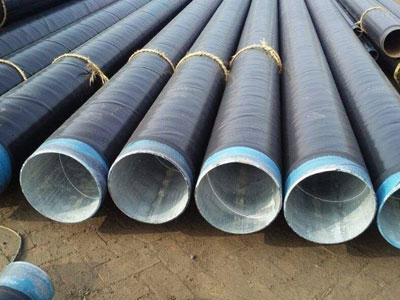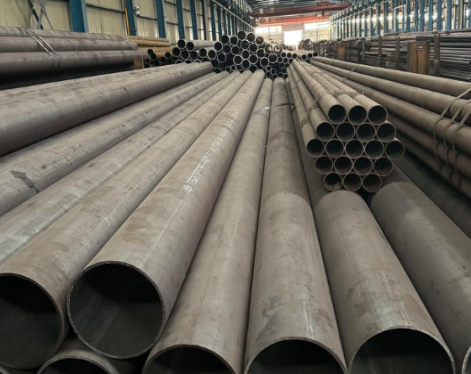Wear-resistant pipes are wear-resistant pipes and wear-resistant pipes, mainly including wear-resistant straight pipes, elbows, tees, big and small heads, square and round joints, variable diameter pipes and other structural parts. It is a pipeline mainly used for the transportation of abrasive materials such as pneumatic and pumped slurry. Because the conveying medium generally has the characteristics of high hardness, fast flow rate, and large flow rate, and has long-term impact, wear, and corrosion on the pipe wall during the conveying process, the pipe is fatigued and gradually worn through. The application of wear-resistant pipes solves this problem.
The structure of the wear-resistant pipe
The wear-resistant pipe is a composite pipe with a wear-resistant layer inside, which is used in the severe wear part of the project, which plays the role of energy saving, emission reduction, wear resistance and anticorrosion. According to different wear conditions, there are also different material choices for wear-resistant pipeline linings.
Wear-resistant ceramic composite pipes are essentially different from traditional steel pipes, wear-resistant alloy cast steel pipes, cast stone pipes, steel-plastic pipes, and steel-rubber pipes. The outer layer of the wear-resistant pipe is seamless pipe, and the inner layer is corundum. The hardness of the corundum layer is as high as HV1100-1400, and the wear resistance is more than 20 times higher than that of carbon steel pipes.

Application of wear-resistant pipe
In addition to being used in coal-fired power plants for ash removal, slag discharge pipes, powder feeding, powder return pipes, and desulfurization pipes, wear-resistant pipes are also used in the following fields:
(1) Coal mines: Coal water slurry in the coal industry, coal washing slime, mine filling materials, mine coal powder;
(2) Metal mines: transportation of concentrates and tailings;
(3) Metallurgy: blast furnace coal injection and slag conveying in iron-making in iron and steel plants; CAO, zinc and sand conveying pipelines, ferroalloy conveying in steel-making, refining outside the furnace, etc.;
(4) Cement plant: raw material slurry transportation, pulverized coal transportation, hoist blanking, finished cement pneumatic transportation loading and unloading, concrete transportation, etc. in the rotary kiln wet process production line;
(5) Chemical plant: transportation of coal powder, silicon powder and other raw materials.
Summarize
The application of wear-resistant pipes has been widely used in electric power, metallurgy, coal, petroleum, chemical industry, building materials, machinery and other industries, and is developing at a high speed. When transporting abrasive materials (such as ash, coal powder, ore powder, tailings, cement, etc.) in the wear-resistant pipeline, there is a problem that the wear-resistant pipeline wears quickly, especially the elbow wears faster . When a highly corrosive gas, liquid or solid is conveyed in the wear-resistant pipeline, there is a problem that the wear-resistant pipeline is corroded and quickly destroyed. When materials with high temperature are transported in wear-resistant pipelines, there is a problem that the price of heat-resistant steel pipes is very expensive. After the wear-resistant pipeline was launched on the market, these problems were all solved. Wear-resistant pipelines are widely used in the transportation of mine filling materials, ore powder and tailings with severe wear and tear. Wear-resistant pipelines for coal-fired thermal power plants are also very suitable for powder delivery, slag removal, and ash transportation. The wear-resistant pipeline is an ideal wear-resistant pipeline for transporting strongly corrosive acids, alkalis, salts, and abrasive solids and liquids. Wear-resistant pipes are very safe and reliable in the occasions of high-temperature corrosion, high-temperature wear or high-temperature erosion.
The structure of the wear-resistant pipe
The wear-resistant pipe is a composite pipe with a wear-resistant layer inside, which is used in the severe wear part of the project, which plays the role of energy saving, emission reduction, wear resistance and anticorrosion. According to different wear conditions, there are also different material choices for wear-resistant pipeline linings.
Wear-resistant ceramic composite pipes are essentially different from traditional steel pipes, wear-resistant alloy cast steel pipes, cast stone pipes, steel-plastic pipes, and steel-rubber pipes. The outer layer of the wear-resistant pipe is seamless pipe, and the inner layer is corundum. The hardness of the corundum layer is as high as HV1100-1400, and the wear resistance is more than 20 times higher than that of carbon steel pipes.

Application of wear-resistant pipe
In addition to being used in coal-fired power plants for ash removal, slag discharge pipes, powder feeding, powder return pipes, and desulfurization pipes, wear-resistant pipes are also used in the following fields:
(1) Coal mines: Coal water slurry in the coal industry, coal washing slime, mine filling materials, mine coal powder;
(2) Metal mines: transportation of concentrates and tailings;
(3) Metallurgy: blast furnace coal injection and slag conveying in iron-making in iron and steel plants; CAO, zinc and sand conveying pipelines, ferroalloy conveying in steel-making, refining outside the furnace, etc.;
(4) Cement plant: raw material slurry transportation, pulverized coal transportation, hoist blanking, finished cement pneumatic transportation loading and unloading, concrete transportation, etc. in the rotary kiln wet process production line;
(5) Chemical plant: transportation of coal powder, silicon powder and other raw materials.
Summarize
The application of wear-resistant pipes has been widely used in electric power, metallurgy, coal, petroleum, chemical industry, building materials, machinery and other industries, and is developing at a high speed. When transporting abrasive materials (such as ash, coal powder, ore powder, tailings, cement, etc.) in the wear-resistant pipeline, there is a problem that the wear-resistant pipeline wears quickly, especially the elbow wears faster . When a highly corrosive gas, liquid or solid is conveyed in the wear-resistant pipeline, there is a problem that the wear-resistant pipeline is corroded and quickly destroyed. When materials with high temperature are transported in wear-resistant pipelines, there is a problem that the price of heat-resistant steel pipes is very expensive. After the wear-resistant pipeline was launched on the market, these problems were all solved. Wear-resistant pipelines are widely used in the transportation of mine filling materials, ore powder and tailings with severe wear and tear. Wear-resistant pipelines for coal-fired thermal power plants are also very suitable for powder delivery, slag removal, and ash transportation. The wear-resistant pipeline is an ideal wear-resistant pipeline for transporting strongly corrosive acids, alkalis, salts, and abrasive solids and liquids. Wear-resistant pipes are very safe and reliable in the occasions of high-temperature corrosion, high-temperature wear or high-temperature erosion.









